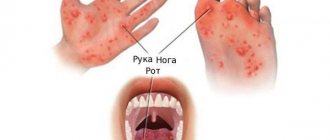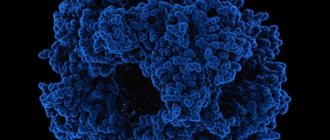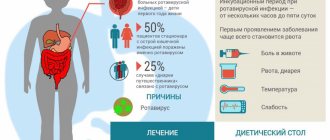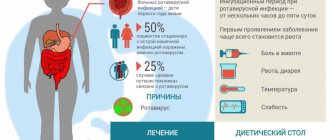Infectious disease specialist
Sinitsyn
Olga Valentinovna
34 years of experience
Highest qualification category of infectious disease doctor
Make an appointment
HIV (human immunodeficiency virus) is a virus that attacks the body's immune system. More precisely, it targets certain immune cells and kills them. The longer and more active this process lasts, the weaker the immune system becomes - over time, it is simply unable to cope even with infections that are relatively safe for an ordinary person.
HIV and AIDS - differences, duration of development, forecasts
AIDS is the final stage of HIV, which is characterized by severely reduced immunity. It is important not to confuse these two concepts. From the moment of HIV infection, the disease can develop to the AIDS stage without treatment within 9-11 years (on average). Once diagnosed with AIDS without treatment, life expectancy is short - on average up to 19 months.
If you start treatment on time, you can live a very long life at the HIV stage - the life expectancy of such patients thanks to modern treatment is 20-50 years. And although at the AIDS stage the situation is much more complicated, many patients, with proper treatment and a strong body, can live more than 10 years.
It is obvious that taking therapy is the most important factor for treating HIV and living a full, long life. Moreover, it is treatment that can significantly reduce the viral load and make the infected person harmless to the partner, as well as family members.
Arterial hypertension
How often: Very often. For example, the US Department of Veterans Affairs reports that 45% of patients with HIV are diagnosed with hypertension. However, scientists are not entirely sure whether this may be due only to HIV infection or treatment with antiretroviral drugs, or a combination of these factors.
Treatment: Stop smoking, weight loss, salt restriction. Vasodilators (for example, hydralazine), antihypertensive drugs (see above), diuretics (hypothiazide, etc.) are used.
Translation by Evgeniy Ignatov
Subscribe to the AIDS.CENTER page on Facebook.
Routes of HIV transmission
Main routes of HIV infection:
- unprotected sex with an infected person (the most common route of HIV transmission). You can become infected either after a single contact or after several;
- using a needle to inject drugs after an infected person. Or other variants of situations in which the blood of a healthy person comes into contact with the blood of an infected person;
- transmission from mother to fetus during childbirth or from mother to child during breastfeeding. An important note: if a woman is treated and is under the supervision of doctors, she has every chance of giving birth to a healthy baby;
- transfusion of infected blood. In modern clinics and hospitals this is no longer possible, since all materials undergo very serious testing.
There are also so-called risk groups - these are people who are more susceptible to HIV infection than others:
- people who are promiscuous;
- homosexuals;
- drug addicts who inject drugs;
- people with a partner infected with the virus.
Such people should constantly get tested. In some cases, they are recommended to take preventive medications (only on the recommendation of a doctor).
When talking about how you can become infected with HIV, you should clarify in what cases this is impossible:
- during everyday contacts;
- when using infected utensils;
- with an insect bite;
- when kissing.
Contact with an HIV-infected person at the everyday level (in the family, at work, in other forms of communication) is absolutely safe and does not pose any threat to others.
Diseases of the cardiovascular system
How often: It is the second leading cause of death among people living with HIV.
Treatment: A comprehensive approach is required, which includes various types of treatment. There are drugs that lower cholesterol levels, such as Crestor (rosuvastatin) and others. Programs that help you quit smoking, lose weight, and exercise are helpful. It is necessary to reduce the consumption of alcohol and salt. If your blood pressure is not at normal levels, your doctor will help prescribe the necessary medications. Options include: ACE inhibitors, angiotensin II receptor blockers, beta blockers, calcium channel blockers.
Main stages of the disease
The stages of HIV are divided into the following:
- incubation This is the stage at which infection and subsequent multiplication of the virus in the blood occurs. It lasts up to six weeks, sometimes less. Even if infected, at this stage a person will not see obvious signs, and a blood test will not show that there are antibodies in the blood;
- primary. The first signs of infection may already appear here. The second stage lasts for 3 weeks - at this time antibodies appear, the virus is determined in the laboratory;
- subclinical. The first sign of the disease appears - enlarged lymph nodes. The patient feels completely healthy and does not complain about his health;
- the appearance of secondary diseases. The immune system begins to malfunction, causing a variety of diseases to appear: from frequent colds and candidiasis to pneumonia, tuberculosis;
- terminal. The stage involves exhaustion (rather rapid and progressive), as well as the subsequent death of the patient.
The stages do not have one correct time frame - they may differ from person to person. For example, HIV-infected people often feel well for years or do not pay attention to small signs. The disease is detected only at the stage of severe deterioration in health or through random tests.
Human immunodeficiency virus/human immunodeficiency syndrome
Wednesday, December 4, 2019
HIV (VIH), or human immunodeficiency virus, affects various organs of the human body (digestive, nervous and other systems), but primarily affects the immune system. As a result of the development of HIV infection, the immune system loses the ability to respond to even the most harmless infections, which a healthy body can easily cope with. Acquired immunodeficiency syndrome, or AIDS, develops. In fact, AIDS is the terminal (final) stage of the development of HIV infection, usually with a fatal outcome. At the same time, it is not AIDS itself or the initial link in the development of AIDS, that is, HIV infection, that is deadly, but diseases that develop against the background of an altered immune status - so-called opportunistic diseases. These include various infectious, oncological or autoimmune diseases (diseases in which the human immune system perceives the body's own cells as foreign and damages them).
Symptoms of HIV infection/AIDS
The first symptoms of HIV infection may appear at the end of the incubation period (2 weeks - 6 months after infection) or a little later.
For many people, this period is asymptomatic, or symptoms may go away on their own, even without treatment; The disease may not manifest itself in any way for several years.
For the acute phase
diseases are typical:
- increased body temperature;
- enlarged lymph nodes (various groups: inguinal, cervical, axillary, etc.);
- erythrematous rash (redness caused by dilation of capillaries) and maculopapular rash (rash in the form of dense convex elements up to 10 mm in size - from flesh-colored to purple) on the face, torso, limbs;
- pain in muscles and joints;
- possible diarrhea (diarrhea), nausea, vomiting;
- possible enlargement of the liver and spleen.
Next, the asymptomatic stage develops .
The asymptomatic stage can occur both in the absence of clinical symptoms and with the development of persistent lymphadenopathy (multiple enlargement of lymph nodes). In exceptional cases, the disease bypasses the asymptomatic phase and progresses until the development of the terminal stage, AIDS. The asymptomatic period can last up to several years.
For persistent lymphadenopathy
characteristic:
- enlargement of at least two groups of lymph nodes (from 1 cm) within 3 months;
- most often the cervical, occipital, and axillary lymph nodes are enlarged;
- enlarged liver, spleen.
The asymptomatic period is followed by a symptomatic chronic phase
of HIV infection
, characterized by the development of various viral, bacterial, and fungal diseases.
This phase is a transitional period between the asymptomatic period of disease development and AIDS; on average, its duration is 3-7 years or more.
The patient is concerned about:
- increased body temperature;
- increased sweating at night;
- diarrhea (diarrhea);
- weight loss.
As a rule, the disease at this stage is accompanied by frequent diseases of the upper respiratory tract and ENT infections:
- otitis (inflammation of the middle ear);
- sinusitis (inflammation of the sinuses);
- tracheitis (inflammation of the trachea);
- tonsillitis (angina).
The transition of HIV infection to the terminal (final) stage, that is, AIDS (acquired immunodeficiency syndrome), is indicated by the appearance of diseases in a sick person, which are normally quite rare in healthy people. These include the following diseases.
Fungal infections of the lungs:
- pneumonia caused by herpes viruses or fungi, most often of the Candida genus;
- Pneumocystis pneumonia (caused by the pathogen Pneumocystis jirovecii). The disease is often observed in HIV-infected people and remains one of the first signs by which AIDS (the presence of HIV infection) is suspected.
Superficial lesions of the skin and mucous membranes.
- Frequent episodes of herpes zoster.
- Various fungal skin diseases (mainly caused by fungi of the genus Candida - hence the name candidiasis).
Accompanied by the formation of a white coating on visible parts of the body and mucous membranes, itching.
Against the background of HIV infection, the fungus often affects internal organs (esophagus, lungs and even the brain).
Externally, the fungal infection has an atypical localization (eyes, rectal sphincter).
Tumor processes that are rare in healthy people.
- Kaposi's sarcoma (herpes virus type 8) in people under 60 years of age. The disease is characterized by multiple malignant skin tumors. It manifests itself by the appearance of purple nodules (seals) on the skin or in the oral cavity, less often on the mucous membrane of the gastrointestinal tract and in the lungs.
- Lymphomas (tumor changes in lymphocytes in tissues) in the bone marrow, spleen and lymph nodes.
Nervous system lesions.
- Toxoplasma brain damage (caused by the single-celled parasite Toxoplasma gondii, which can infect the brain and cause the development of encephalitis (an inflammatory process in the brain)).
- Cryptococcal meningitis is an infectious disease affecting the meninges caused by the fungus Cryptococcus neoformans. Accompanied by high body temperature, headache, fatigue, nausea, vomiting, and seizures.
- Progressive multifocal leukoencephalopathy is a disease in which the myelin layer covering the long processes of nerve cells (axons) is gradually destroyed, resulting in disruption of the conduction of nerve impulses, which can cause the development of paralysis, impaired hearing, vision and other severe neurological disorders.
The cause of the disease is polyomavirus. The virus is present in the body of most absolutely healthy people and does not manifest itself in any way. Activation of the virus occurs against the background of reduced immunity. The person dies within a few months of the first symptoms appearing.
Diagnostics
Early diagnosis of HIV infection is complicated by the fact that the initial symptoms also occur in various other diseases and are not directly characteristic of HIV infection. However, HIV is suspected if the following symptoms occur:
- unmotivated fatigue;
- increased sweating at night;
- headache;
- elevated body temperature for 3-10 days (38-38.5 ° C);
- prolonged diarrhea (diarrhea);
- weight loss;
- the presence of a rash or furunculosis (multiple painful inflammations with the formation of cavities filled with pus);
- enlarged lymph nodes.
HIV infection is suspected in the following conditions:
- Pneumocystis pneumonia (fungal pneumonia), fungal infection of the nervous system and internal organs;
- confirmed Kaposi's sarcoma in persons under 60 years of age;
- cerebral toxoplasmosis (brain infection caused by Toxoplasma);
- herpes zoster in people under 50 years of age.
Laboratory diagnostics.
At the initial stages of the disease, antibodies to HIV, as a rule, are not detected, therefore the main diagnostic method is PCR (polymerase chain reaction), a method for detecting viral RNA.
ELISA (enzyme-linked immunosorbent assay) to detect antibodies to HIV. Antibodies are usually detected 3 months after infection.
Immunoblotting (the method is used after a positive ELISA result). The essence is to determine specific antibodies to the 3 main antigens of the virus envelope.
Complications and consequences
In fact, the complications and consequences of HIV infection are nothing more than signs of the development of AIDS.
The picture of full-blown AIDS is characterized by the following diseases.
- Tuberculosis (in HIV-infected people it is diagnosed for the first time, in others there are repeated episodes of the disease).
- Toxic hepatitis (inflammation of the liver due to exposure to chemicals of various natures: poisons, mushrooms, alcohol, medications).
- Pneumocystis pneumonia (pneumonia, the causative agent of which is a yeast fungus) with the development of respiratory and cardiovascular failure (death is observed in half of the cases).
- In addition to fungal infection of the lungs, fungal infection of the brain and meninges is also common.
- Cytomegalovirus infection (herpes virus infection type 5), occurring against the background of high body temperature with damage to the respiratory and digestive organs, and decreased visual acuity.
- The development of a generalized herpes virus infection (herpes simplex virus) is also characteristic: signs of herpetic skin lesions (rashes in the form of blisters filled with transparent contents) persist for more than a month, then the bronchi, lungs, esophagus, etc. are involved in the process.
- Toxoplasmosis is a parasitic disease caused by Toxoplasma gondii.
- Kaposi's sarcoma (vascular tumor affecting the skin, mucous membranes and internal organs).
- Against the background of HIV infection, various diseases of a bacterial, viral, or fungal nature can develop. Each can occur with its own set of complications, affecting various organs and entire systems.
Prevention of HIV infection/AIDS
- Informing young people about the spread and danger of AIDS/HIV and other sexually transmitted diseases, as well as the role of barrier contraception in preventing infection.
- Avoid casual sex, use barrier methods of contraception during sexual intercourse.
- Monitoring of transfused blood components and blood products.
- Strict adherence to aseptic rules when processing medical instruments.
- Use of disposable systems, syringes and injection needles.
- Registration of HIV-infected people in specialized centers.
- Before hospitalization in a hospital or performing surgical procedures, it is mandatory to take tests for HIV.
- Prevention of drug addiction, education of injection drug users regarding the risk of infection when using shared syringes and needles.
- Avoid breastfeeding if the mother is HIV positive.
Symptoms of HIV
Once you know how HIV is transmitted, you need to understand the symptoms. The problem is that these symptoms appear at an early stage, then disappear and no longer bother the person for a long time - literally for years. They are also very similar to the manifestations of other diseases, which can be misleading.
So, at the first stage, when the virus manifests itself, a person may feel:
- sore throat, fever;
- soreness of the skin, joints, bones4
- chills, fever.
At the same time, the cervical lymph nodes enlarge and various rashes may appear. All this is often mistaken for signs of ARVI or other similar diseases.
New HIV symptoms return after several years of a calm and healthy life. These include:
- severe fatigue, fatigue;
- enlargement of lymph nodes - not only in the cervical, but in several groups;
- weight loss. Usually it looks causeless, the person does not understand what is going on;
- fever, chills, sweating (mostly at night);
- problems with the gastrointestinal tract - usually manifested by loose stools for no apparent reason.
At this stage, as a rule, the disease is detected - because the patient goes to the doctor, and the specialist prescribes an additional examination.
Are you experiencing symptoms of HIV?
Only a doctor can accurately diagnose the disease. Don't delay your consultation - call
Complications
Much attention is paid to the treatment and prevention of infection with the human immunodeficiency virus due to the fact that the infection leads to various severe complications associated with the development of an immunodeficiency state.
Candidiasis of the oropharynx, esophagus and respiratory tract occurs against the background of activation of yeast-like fungi of the genus Candida. Typical symptoms include discomfort when swallowing, sore throat, the appearance of white deposits on the mucous membranes of the mouth, and an increase in temperature to subfebrile levels.
Shingles is a reactivation of the varicella zoster virus, which is stored for life in the nerve ganglia after the initial infection. Itchy blistering rashes appear along the nerve trunks in the back and chest, which form painful and itchy crusts.
Tuberculosis infection is caused by mycobacteria entering the body. Characterized by sweating, cough, fever, shortness of breath. In HIV-positive people, tuberculosis is prone to a severe generalized course, affecting organs other than the lungs.
Kaposi's sarcoma often occurs - a malignant lesion with multiple foci, originating in the vascular area. The skin, mucous membranes, internal organs and lymphatic capillaries are mainly affected.
Pneumocystis pneumonia is a severe lesion of the lung tissue, typical of patients with immunodeficiencies. It is manifested by high fever, severe shortness of breath and severe general condition.
Cerebral toxoplasmosis is a parasitic pathology in which people with immunodeficiencies develop pathological lesions in the brain area, leading to neurological disorders (seizures, headaches, cognitive impairmentSource: Molecular epidemiology of HIV. AJ Kandathil, S Ramalingam, R Kannangai, Shoba David , G Sridharan. Indian J Med Res, 2005 Apr;121(4):333-44. https://pubmed.ncbi.nlm.nih.gov/15817947/.
How is HIV diagnosed in Moscow?
There are two tests to diagnose the virus: preliminary ELISA and the most accurate immunoblot. The accuracy of ELISA is about 90%. It is recommended to carry out it 3-6 months after contact with the virus, then it gives maximum accuracy. The usual ELISA test is based on a blood test, but there are also rapid tests that help obtain information based on urine or saliva. Such texts are purchased exclusively at the pharmacy (in no case on the Internet!), since it is necessary to use officially approved products.
If the rapid test gives a positive result, you need to go to an infectious disease specialist yourself. In such a situation, as well as when ELISA in a blood test gives a positive result, the patient is prescribed an immunoblot. Its reliability is already 99.9%. Depending on the diagnosis, the diagnosis is made either on the basis of two repeated tests or a combination of both. The analysis is rechecked and only after this a diagnosis can be made. This is necessary in order to exclude false positive results that may occur during the diagnostic process.
Important: the test does not show how HIV is transmitted in a particular situation - that is, you can determine the route of infection only by analyzing your own actions.
How to protect yourself
Considering the main methods of HIV infection, doctors identify several simple rules for preventing the problem:
- Avoid casual sex. Most likely, you know a little about the sex life of a potential partner. In any case, use contraception. You can catch a dangerous virus as a result of traditional sex. But is it possible to become infected with HIV through oral or anal sex? Unfortunately, yes, so be as careful as possible.
- Use only new, sterile needles and syringes. This is often neglected by drug addicts, creating optimal conditions for the transmission of the disease. If you are donating blood or are on an IV in the hospital, make sure that the nurses only use new needles and syringes. Their inattention or your false economy are the causes of the problems.
- Be careful in beauty salons. Infection is only possible if the instruments are not disinfected and there is contact with blood. Check the first and contact experienced specialists.
- Be careful with blood transfusions. Trust only trusted medical institutions. Agree to a blood transfusion if there is no other alternative. See for yourself or ask your doctor to look at the donor’s medical record.
- Do not leave open wounds . An antiseptic and a sterile bandage prevent dust and fluids from an infected person from entering the wound. Do not be lazy to treat a small scratch yourself and seek qualified medical help in case of serious damage.
Simple rules can reduce the likelihood of catching a disease to almost zero.
HIV treatment
Treatment boils down to prescribing antiretroviral therapy. The patient is given a medication regimen - and it must be followed as precisely as possible, without deviating from the program. Otherwise, the virus may develop resistance to treatment and cannot be further suppressed.
Indicators of quality treatment are a decrease in the viral load, as well as an increase in CD4+ cells in the blood, which indicates the activity of the immune system.
Medicines for treatment are issued in medical institutions, patients are registered and receive medications free of charge, in accordance with the established procedure. Information about the disease is confidential - it is not sent to work, place of study or other places. The patient has the right to keep it secret (if this is not provided for in separate work contracts).
If the rules for taking therapy are followed, the virus in the blood gradually decreases; over time, the patient becomes completely safe for his sexual partner and is not able to infect anyone.
Pathogenesis
After entering the body, the virus attacks immune cells, on the surface of which specific structures (CD4 receptors) are present. These are T-lymphocytes, macrophages, monocytes, microglia, dendritic structures and Langerhans cells. HIV infection is characterized by a wave-like course, in which the number of viral particles in the patient’s body gradually increases. The main pathological mechanism leading to the development of complications of the disease is the active destruction of immunocompetent structures. As already mentioned, HIV destroys affected cells after the release of new virions, so immune resources are gradually depleted.
The main pathological effects of the disease:
- Mass destruction of cells necessary to protect the body from pathogenic microorganisms. At a certain stage, the immune system loses its ability to protect tissues from other bacteria, viruses and fungi. At the same time, the body begins to attack even conditionally pathogenic microorganisms that normally inhabit organs and tissues.
- Components of the immune system cease to protect the body from the division of damaged cells, resulting in an increased risk of the formation of malignant tumors.
- The human immune system begins to attack healthy tissue. Patients suffering from HIV infection are often diagnosed with various forms of damage to the nervous system.
Thus, pathology gradually inactivates the protection of the patient’s tissues and organs from dangerous microorganisms, so most deaths are associated with secondary infections. Without treatment, death occurs within 10-12 years after viral invasion.
Prevention of HIV infection
The first and most important rule is to be regularly tested for HIV, even if you have not had suspicious contacts. It is recommended to be examined once every six months - especially since there are convenient rapid tests for this.
You also need to be careful when choosing partners. You should not take the word of a person who says that he is definitely not sick - it is better to ask for the results of the study and see for yourself that you can trust him. But remember that within six months even contaminated blood may not give positive results.
HIV prevention consists of the following points:
- protected sex with non-regular sexual partners, as well as regular ones, if there is no confidence that the partner is not sick or is faithful;
- exclusion from life of drugs and promiscuity;
- maintaining general hygiene. Avoid sharing razors, toothbrushes, nail clippers, and other items that may come into contact with small wounds.
The main prevention is to be aware of the infection and always remember the danger of infection.
Mood changes, including depression and anxiety
How often: According to AIDS Beacon, 63% of HIV-positive participants in a recent study reported having either current or past symptoms of depression, 26% had suicidal ideation, and 13% of participants had attempted suicide. suicide.
Treatment: The most effective drugs that alleviate this condition are serotonin reuptake inhibitors. The US National Institutes of Health recommends the following medications to treat depression in patients with HIV: imipramine, desipramine, nortriptyline, amitriptyline, fluoxetine, sertraline, paroxetine, citalopram, escitalopram, fluvoxamine, venlafaxine, nefazodone, trazodone, bupropion, and mirtazapine.
Popular questions and answers about HIV
How does HIV manifest in men and women?
The symptoms of HIV in women are exactly the same as the symptoms of HIV in men. Manifestations may differ only at the level of genitourinary diseases, when the body is already very weakened - for example, thrush appears more often in women. Otherwise, there are no specific signs by gender.
Is there a cure for HIV?
Technically, we can say that there is no cure for HIV - patients are constantly required to undergo special therapy. But the results that it allows to achieve make the patient a healthy person who can live calmly for decades without any problems - you just need to constantly take medications and monitor your health.
HIV has not been a fatal disease for a long time!
Is HIV a disease of drug addicts and people with disordered lifestyles?
In fact, this is a myth that HIV activists are constantly dispelling. Unfortunately, a person who leads a healthy lifestyle and is responsible for their relationships can also get this disease. It is enough that a sexual partner can cheat – and in this way “bring” illness to the couple. HIV is not always a sign of an irresponsible attitude towards one’s life.
Who are HIV dissidents?
These are people who, contrary to scientific data and common sense, deny the existence of the virus. They refuse treatment, which inevitably leads to early death. Such people are also dangerous because, due to lack of treatment, they spread the virus among their sexual partners without warning them of the possible danger (because they do not believe that it exists).
The success of HIV treatment and long life lies in seeking help and starting therapy as early as possible. In this case, a person will have a long life without fears and difficulties.
Features of the virus
HIV is a retrovirus belonging to the lentivirus genus. The features of this pathogen include a long incubation period, the presence of RNA as genetic material, and the ability to replicate in non-dividing cells. After invasion, HIV converts its own RNA into double-stranded DNA and integrates the resulting molecule into the genetic structure of the cell. For all necessary transformations, special enzymes are used, including reverse transcriptase and integrase. After embedding, the viral structure can remain hidden for a long time, which is why the human immune system does not respond to the presence of pathology. It is noted that HIV can remain asymptomatic even for ten years after entering the body.
Types of pathogen
- HIV-1 is a primary infectious agent discovered and described in 1983. It was this virus that spread throughout the world in the last century. In different countries, different proportions of HIV-1 subtypes and groups can be found. For example, subtype A of the main group of HIV-1 is common in the CIS and West Africa.
- HIV-2 is an infectious agent discovered in 1986. There are significant genetic differences between this pathogen and HIV-1. In European countries, this virus is rare.
Some time after the viral DNA is integrated into the cellular genome, the disease spreads. HIV uses cellular resources to assemble virions. As a result, several new pathogens are formed that can spread in the patient's body. In this case, the infected cell is destroyed after the virions are released. It is noted that the viral genome can penetrate the structure of chromosomes and remain in human cells even after long-term drug therapy, so scientists are pinning their hopes on developing methods for editing genetic information.
Occurs in childhood
The child's body is constantly developing, so any pathological effects on organs and tissues can cause serious complications. Pediatricians know that the main complication of HIV infection in children is delayed mental and physical development. If not treated in a timely manner, disability and even death of the child may occur.
Other specific signs:
- frequent relapses of bacterial infections;
- different forms of brain damage;
- lymphoid pneumonia;
- anemia.
The most severe course is typical for HIV infection that occurs during fetal development. A common cause of death is increased bleeding, which develops against the background of a decrease in the number of platelets and impaired hemostasis.
Diagnostics
The specific method for diagnosing the disease depends on the expected stage of HIV infection. Most hospitals and medical centers can offer the patient a wide range of laboratory tests that can detect the disease at any stage of development. The most common way to detect the disease is to test for the presence of antibodies to HIV. Specific immunoglobulins most often appear in the patient’s blood within 2-3 months after invasion, so this laboratory test is constantly used as a screening. At the same time, such an analysis is not suitable for patients with a terminal form of the pathology, since with severe immunodeficiency, antibodies may not be synthesized.
Basic diagnostic methods
- Enzyme immunoassay is the already mentioned indirect test, which makes it possible to detect specific immunoglobulins in the patient’s blood.
- Immunoblotting is a more accurate method for detecting antibodies in the blood. This test is usually used to confirm the result of an enzyme immunoassay.
- Polymerase chain reaction is a direct test necessary to detect genetic particles of the virus in the patient's body.
- Rapid tests based on immunochromatography, agglutination reaction and other methods. The accuracy of such analyzes is significantly inferior to other laboratory tests.
For a thorough examination and proper selection of laboratory tests, it is recommended to consult a doctor. The specialist will ask the patient about complaints, study medical history and conduct a physical examination. Please note that antibody tests do not detect HIV during the window period (2 weeks to six months), so even if the result is negative, repeat testing may be required.









